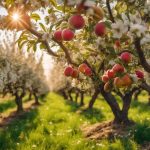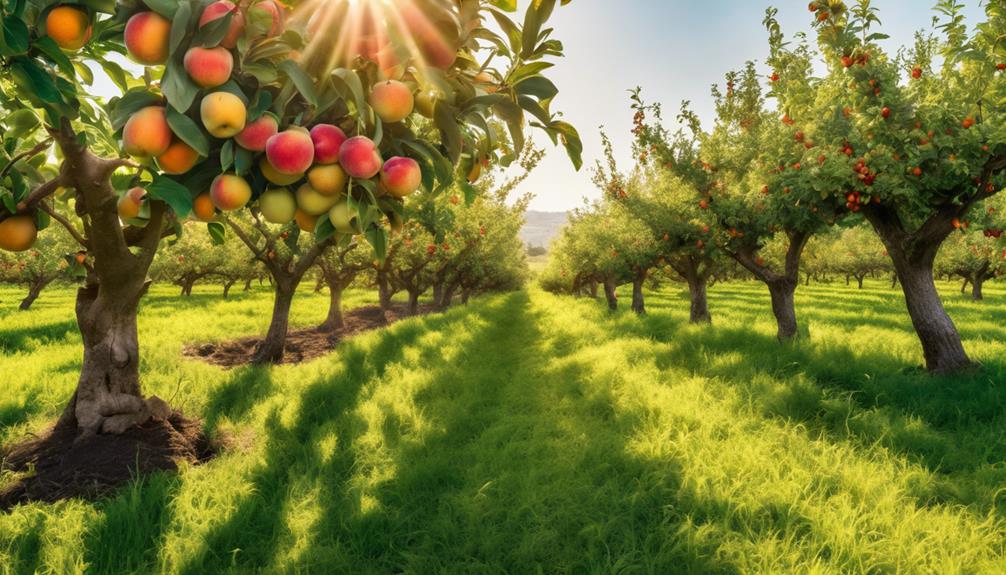
Tree Pruning Techniques for Healthy Fruit Trees
5 October 2024
What Does Professional Tree Care Entail?
5 October 2024Top tree pruning services are essential for ensuring healthy fruit trees and maximising their yield.
Expert horticulturists employ techniques such as thinning, heading, and spur pruning, which promote light penetration and air circulation, both of which are fundamental for fruit quality.
The ideal time for pruning typically falls in late winter or early spring, preparing trees for vigorous growth.
Effective tools such as sharp secateurs and loppers are crucial for achieving clean cuts.
With proper care and attentive methods, you can enhance tree vitality and prevent disease.
Explore the opportunities for optimising the health and productivity of your fruit trees for a bountiful harvest.
Pruning Techniques for Fruit Trees
Pruning techniques are crucial for maintaining the health and productivity of fruit trees.
Key methods, such as thinning and heading cuts, can significantly influence fruit quality and yield when applied at the appropriate time.
Understanding the best timing for these techniques is fundamental for fostering robust growth and maximising harvest potential.
Essential Pruning Methods
A well-executed pruning strategy is vital for the importance and productivity of fruit trees.
Employing methods such as thinning, heading, and renewal pruning can greatly improve tree health and fruit yield. Thinning involves selectively removing branches to enhance light penetration and air circulation, preventing disease and promoting even fruit development.
Heading, on the other hand, entails cutting back branches to stimulate growth, encouraging a more compact and manageable tree structure.
Renewal pruning focuses on removing older, unproductive wood to make way for new growth, ensuring longevity.
Each technique requires precise execution, timing, and an understanding of the specific tree species to optimise results. Mastery of these vital pruning methods is significant for any fruit tree cultivator aiming for peak performance.
Timing for Optimal Growth
Understanding the appropriate timing for pruning is fundamental to maximising the growth and productivity of fruit trees. Pruning in late winter to early spring, before bud break, is typically ideal, as it encourages robust growth during the growing season.
This timing allows for the removal of dead or diseased wood, improving sunlight penetration and air circulation. Conversely, summer pruning can be beneficial for managing tree height and redirecting energy towards fruit production.
However, it is advisable to avoid late-season pruning, as it may stimulate new growth that will not harden off before winter.
Therefore, mastering the timing of pruning not only boosts the health of fruit trees but also guarantees a bountiful harvest, aligning growth with seasonal rhythms for the best results.
Pruning Timing and Seasonality
Understanding the ideal timing for pruning is fundamental for promoting the health of fruit trees, as it varies based on tree variety and growth habit.
Furthermore, soil quality and nutrient availability play an important role in determining when to prune for maximum effectiveness.
Effective pruning also aids in pest management, making careful timing even more significant for sustaining tree vigour.
Tree Variety and Growth Habit
While the specific pruning requirements of fruit trees can vary significantly based on their variety and growth habit, timing and seasonality play essential roles in promoting healthy development.
Understanding these factors can optimise your pruning strategy:
- Deciduous Trees: Prune in late winter or early spring before new growth begins.
- Evergreen Varieties: Conduct pruning in late spring or early summer to maintain their shape.
- Fruit-bearing Types: For stone fruits, prune in late summer; for pome fruits, focus on winter.
- Training Young Trees: Early intervention is critical for shaping, ideally performed during the dormant season.
Soil Quality and Nutrients
Healthy fruit trees depend not only on proper pruning techniques but also on the quality of the soil and the availability of essential nutrients.
Optimal soil conditions foster robust root systems, enhancing nutrient uptake and overall tree health. To ensure your fruit trees thrive, consider the following key factors:
- Soil Composition: Maintain a balanced mix of sand, silt, and clay for ideal drainage and aeration.
- pH Levels: Regularly test and adjust soil pH to ensure it falls between 6.0 and 7.0, which is perfect for most fruit trees.
- Nutrient Availability: Incorporate organic matter, such as compost, to enrich the soil and supply essential nutrients.
- Water Management: Implement effective irrigation practices to prevent both drought stress and waterlogging.
Pruning for Pest Management
Effective pest management for fruit trees is significantly influenced by the timing and seasonality of pruning. Properly timed pruning can greatly reduce pest populations and improve tree health.
Here are four crucial considerations for timing your pruning efforts:
- Dormant Season Pruning: Conduct pruning during late winter or early spring when trees are dormant to minimise stress and exposure to pests.
- Post-Bloom Pruning: Prune after flowering to remove any infested branches without affecting fruit set.
- Summer Pruning: Utilise summer pruning to control growth and enhance air circulation, thereby reducing the habitat for pests.
- Pest Observation: Regularly inspect trees throughout the growing season to ascertain if immediate pruning is necessary in response to pest outbreaks.
Tools for Effective Pruning
Effective tree pruning requires the right tools and techniques to ensure optimal results.
Evaluating tree health is crucial before commencing the pruning process, as it informs the necessary actions to take.
Moreover, maintaining clean and sterilised tools is important to prevent the spread of disease, while crown thinning enhances light penetration for healthier fruit production.
Assessing Tree Health First
Before commencing the pruning process, it is essential to assess the overall health of fruit trees to ensure the best results.
A thorough evaluation enables informed decisions that enhance tree vitality and fruit production. Here are key indicators to examine:
- Foliage Condition: Inspect leaves for discolouration or pests that may indicate disease.
- Branch Structure: Assess for dead or crossing branches, which can impact growth and airflow.
- Trunk Integrity: Look for signs of decay or damage that may compromise stability.
- Root Health: Evaluate the root zone for any signs of rot or inadequate drainage.
Clean and Sterilize Tools
Once the health of fruit trees has been assessed, the next step involves preparing the necessary tools for pruning.
Confirming that your tools are clean and sterilised is vital to prevent the spread of diseases and pests. Here are key steps to achieve this:
- Gather Supplies: Collect rubbing alcohol, disinfectant wipes, and a clean cloth.
- Remove Debris: Clear any dirt or sap from cutting surfaces using the cloth.
- Disinfect Tools: Soak the blades in rubbing alcohol for at least 10 minutes to eliminate pathogens.
- Dry Properly: Wipe tools dry to prevent rust and ensure they are ready for immediate use.
Crown Thinning for Light Penetration
Crown thinning is an essential practice that allows light to penetrate the tree canopy, promoting healthier growth and fruit production. This technique enhances air circulation and reduces the risk of disease.
To effectively perform crown thinning, consider employing the following tools:
- Bypass Pruners: Ideal for clean cuts on live branches, encouraging quick healing.
- Loppers: Useful for reaching higher branches, enabling precise cuts on thicker limbs.
- Hand Saw: Necessary for larger branches that require more robust cutting power.
- Pole Pruner: Extends your reach, making it easier to access elevated areas without compromising safety.
Mastering these tools will ensure that your crown thinning efforts yield optimal results for your fruit trees.
Increased Fruit Yield Potential
Optimising fruit yield potential begins with effective tree pruning techniques that promote healthy growth and ideal fruit production. Pruning improves air circulation and light exposure, both of which are critical for fruit development. By removing excessive or weak branches, resources are redirected to stronger limbs, fostering larger and more abundant fruit.
| Pruning Technique | Impact on Yield |
|---|---|
| Crown Thinning | Enhances light penetration |
| Heading Cuts | Encourages new growth |
| Spur Pruning | Optimises fruiting sites |
These strategic interventions are fundamental for maintaining tree vitality and improving fruit quality. Mastery of pruning techniques will ultimately lead to a more fruitful harvest, ensuring that your trees reach their optimal potential each season.
Fruit Tree Training Methods
Effective fruit tree training methods are crucial for maximising the health and productivity of trees.
By strategically pruning for ideal sunlight exposure, disease prevention, and fruit size improvement, growers can greatly enhance overall yield and fruit quality.
This approach not only fosters robust growth but also ensures that trees remain resilient against environmental challenges.
Pruning for Optimal Sunlight Exposure
Achieving ideal sunlight exposure is crucial for the health and productivity of fruit trees, as it directly influences photosynthesis and fruit quality. Effective pruning techniques facilitate light penetration, ensuring that all parts of the tree receive adequate sunlight.
To enhance sunlight exposure, consider implementing the following methods:
- Selective Thinning: Remove overcrowded branches to increase airflow and light access.
- Canopy Management: Train branches to grow outward rather than upward, maximising horizontal light exposure.
- Seasonal Pruning: Carry out pruning during dormancy to prepare the tree for peak growth in spring.
- Maintaining Open Centres: Adopt an open-centre structure to allow sunlight to reach the inner branches.
Pruning for Disease Prevention
Pruning for disease prevention is essential for maintaining the health and longevity of fruit trees. By meticulously removing affected branches and ensuring proper air circulation, you can significantly reduce the risk of disease.
Here are four fundamental practices to enhance your pruning strategy:
- Remove Dead or Diseased Wood: Cut away any branches that display signs of rot, fungal infections, or pests to limit the spread of pathogens.
- Thin Crowded Areas: Prune to improve airflow, which helps prevent moisture accumulation that fosters disease.
- Avoid Over-Pruning: Excessive removal of foliage can stress the tree, making it more susceptible to infections.
- Sanitise Tools: Always disinfect pruning tools between cuts to prevent the transmission of diseases.
Implementing these techniques will promote robust fruit tree health.
Pruning for Fruit Size Enhancement
Healthy fruit trees not only resist diseases but also produce larger and more flavourful fruit. Pruning is a crucial technique for enhancing fruit size, allowing for optimal sunlight exposure and airflow.
Implement the following methods for effective fruit tree training:
- Thinning: Remove excess fruit and smaller branches to redirect energy towards larger fruits.
- Heading Back: Cut back branches to encourage new growth, which can lead to the development of larger fruit.
- Summer Pruning: Carry out light pruning during the growing season to reduce competition among fruit.
- Proper Spacing: Ensure adequate distance between branches to optimise light penetration.
Pruning Timing Miscalculations
Pruning timing miscalculations can significantly affect the health and yield of fruit trees.
It is essential to prune after the flowering season or during the dormant phase to avoid stress and promote optimal growth.
Understanding these timing nuances is crucial for effective tree management and maximising fruit production.
Timing Mistakes in Pruning
Timing is a crucial factor in the successful pruning of fruit trees, as miscalculations can lead to detrimental effects on their growth and productivity.
Understanding the ideal timing for pruning is fundamental to avoiding common mistakes that can hinder your tree's development.
Here are four critical timing mistakes to avoid:
- Pruning Too Early: Cutting branches before trees have fully entered dormancy can stimulate premature growth.
- Pruning Too Late: Delaying pruning until buds swell can result in the loss of potential fruit due to shock.
- Ignoring Seasonal Changes: Failing to take into account climate variations can misalign your pruning schedule with the tree's natural cycle.
- Neglecting Tree Maturity: Different maturity categories require distinct pruning timings for optimal health and yield.
Mastering these timing nuances will greatly enhance your fruit tree management strategy.
Prune After Flowering Season
When should you consider pruning your fruit trees to enhance their health and productivity? Pruning after the flowering season is crucial for maintaining the vitality of your trees. This timing allows you to remove dead or diseased wood without impeding fruit development.
To optimise your pruning efforts, consider these key practices:
- Assess Flowering Success: Evaluate the health of the blossoms to identify areas requiring attention.
- Remove Excess Growth: Trim back excessive shoots that can detract from fruit production.
- Improve Air Circulation: Open the canopy to promote airflow, thus reducing the risk of disease.
- Shape for Future Growth: Establish a framework for balanced growth in subsequent seasons.
Prune During Dormancy Phase
During the dormancy phase, fruit trees enter a period of rest that presents an ideal opportunity for pruning. This critical timing allows for effective rejuvenation and improves future fruit production.
Pruning during dormancy minimises stress on the tree and encourages robust growth in the subsequent growing season. To achieve the best results, consider these key principles:
- Assess Tree Structure: Identify and remove any dead or diseased branches.
- Maintain Airflow: Thin out crowded areas to improve light penetration.
- Shape the Canopy: Promote an open centre to boost growth and fruit development.
- Timing is Crucial: Prune when temperatures are consistently below freezing to protect against injury.
Mastering these techniques will ensure your fruit trees thrive and yield bountiful harvests.
Why Choose TKL Birmingham Gardener
Choosing the right gardening service can significantly influence the health and productivity of your fruit trees, and TKL Birmingham Gardener is an outstanding choice.
With a team of certified horticulturists, TKL Birmingham Gardener employs advanced pruning techniques tailored to the specific needs of various fruit tree species. Their meticulous approach not only enhances tree structure but also maximises yield and fruit quality.
By utilising environmentally sustainable practices, TKL emphasises organic methods that promote soil health and biodiversity. Clients benefit from thorough assessments and customised care plans designed to address individual tree conditions and growth objectives.
Trusting TKL Birmingham Gardener ensures that your fruit trees receive the expertise and attention necessary for optimal growth, resulting in vibrant, fruitful trees for years to come.
Common Pruning Questions Answered
Many homeowners have questions about the best practices for pruning their fruit trees, as proper techniques are vital for maintaining tree health and productivity. A common inquiry pertains to the ideal time for pruning; generally, late winter or early spring before new growth begins is recommended.
Furthermore, many wonder how much to prune; a good rule of thumb is to remove no more than 25% of the tree's canopy in a single season to avoid stress.
Another frequent concern is the method of pruning; utilising clean, sharp tools and making precise cuts at the branch collar promotes optimal healing.
Plan Your Seasonal Pruning
To ensure the optimal health and productivity of your fruit trees, planning your seasonal pruning is essential. Effective pruning enhances air circulation, sunlight penetration, and fruit quality.
Here are four key steps to consider when planning your seasonal pruning:
- Timing: Identify the best season for pruning specific fruit tree varieties, which is typically late winter or early spring.
- Assessment: Evaluate the tree's structure, health, and growth patterns to guide your pruning cuts.
- Tools: Ensure you have the appropriate tools, such as sharp secateurs and loppers, to make clean cuts.
- Technique: Familiarise yourself with proper pruning techniques, focusing on removing dead or diseased wood and shaping the canopy.




